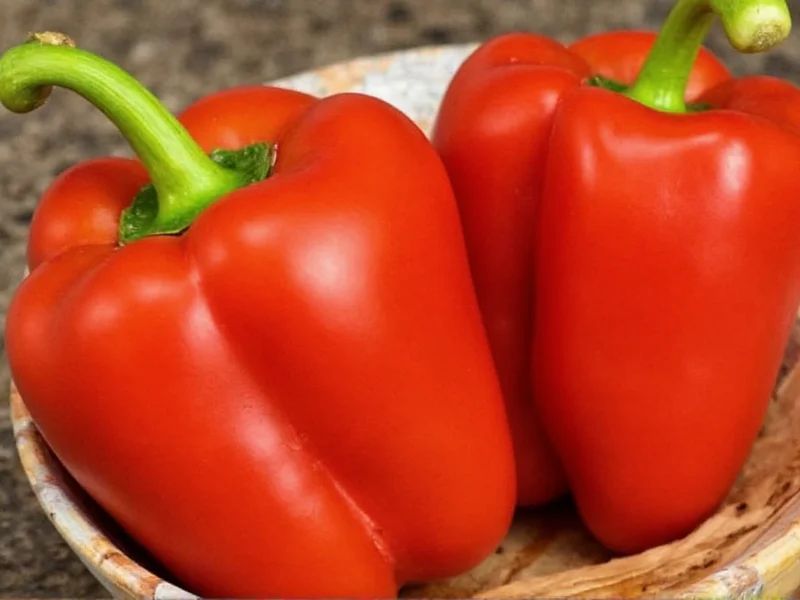Understanding bell pepper sweetness starts with recognizing that color directly correlates with ripeness and sugar development. As bell peppers mature on the plant, they transition from green through yellow and orange to red, accumulating natural sugars at each stage. This biological process explains why fully ripe peppers deliver noticeably sweeter flavors.
The Science Behind Bell Pepper Sweetness
Bell peppers undergo significant biochemical changes as they ripen. The chlorophyll that gives green peppers their color breaks down, revealing carotenoids that produce yellow, orange, and red hues. Simultaneously, starches convert to sugars, particularly fructose and glucose, creating that desirable sweetness. This maturation process typically takes 2-3 weeks longer than harvesting at the green stage, which explains the higher price point for colored varieties.
Sweetness Comparison by Color
| Bell Pepper Color | Sweetness Level (1-10) | Sugar Content (per 100g) | Ripeness Stage |
|---|---|---|---|
| Yellow | 8.5 | 4.2g | Fully ripe |
| Orange | 8.7 | 4.5g | Fully ripe |
| Red | 8.2 | 4.0g | Fully ripe |
| Green | 5.0 | 2.4g | Unripe |
Factors Influencing Sweetness Beyond Color
While color provides a reliable indicator, several other factors affect bell pepper sweetness:
1. Growing Conditions
Sun exposure, soil quality, and water management significantly impact sugar development. Peppers grown in optimal conditions with consistent watering and adequate sunlight develop higher sugar concentrations. The Capsicum annuum species responds particularly well to warm temperatures during fruit development, which enhances sweetness.
2. Harvest Timing
Even within the same color category, harvest timing matters. Peppers left on the vine until fully colored and slightly soft to the touch contain maximum sugars. Commercial growers sometimes harvest red peppers when they're still partially orange to reduce field time, resulting in less sweetness.
3. Specific Varieties
Certain cultivars have been bred specifically for sweetness. The Golden California Wonder yellow pepper and Orange Sun varieties consistently rank among the sweetest options available. When selecting seeds or plants, look for terms like "sweetest bell pepper varieties" or "high-sugar bell peppers" in descriptions.
Practical Selection Tips for Consumers
When shopping for the sweetest bell peppers, examine these characteristics:
- Weight: Heavier peppers for their size indicate higher water and sugar content
- Shine: A glossy skin suggests freshness and optimal sugar development
- Shape: Symmetrical peppers with four lobes often develop more evenly and sweetly
- Stem: A green, moist stem indicates recent harvest and peak freshness
Store bell peppers in the crisper drawer of your refrigerator for up to two weeks. Note that sweetness doesn't increase after harvest—unlike some fruits, bell peppers don't continue ripening significantly off the vine.
Nutritional Implications of Ripeness
The ripening process that increases sweetness also boosts nutritional value. Fully ripe yellow, orange, and red bell peppers contain significantly higher levels of vitamin C, beta-carotene, and antioxidants compared to green peppers. For example, red bell peppers contain nearly 11 times more beta-carotene and 1.5 times more vitamin C than their green counterparts. This makes the sweeter varieties not only more flavorful but also more nutritionally dense.
Common Misconceptions About Bell Pepper Sweetness
Several myths persist about bell pepper sweetness. Many believe purple or chocolate-colored varieties are the sweetest, but these are typically just intermediate ripening stages with sugar levels comparable to green peppers. Others assume smaller peppers are sweeter, but size relates more to variety than sugar content. The most reliable sweetness indicator remains the final color stage—yellow and orange peppers consistently deliver the highest natural sugar levels among commercially available varieties.
Culinary Applications of Sweet Bell Peppers
The superior sweetness of yellow and orange bell peppers makes them ideal for raw applications where their flavor shines without cooking. They excel in salads, crudités, and as pizza toppings. Red peppers, while slightly less sweet, develop wonderful caramelized flavors when roasted. Green peppers' lower sugar content makes them better suited for dishes requiring less sweetness, like stuffed peppers or fajitas where their grassier notes complement other ingredients.











 浙公网安备
33010002000092号
浙公网安备
33010002000092号 浙B2-20120091-4
浙B2-20120091-4